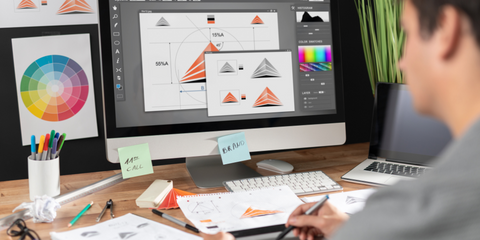Introduction:
In the world of design, choosing the right file format for a project is crucial for ensuring the best quality and functionality. Whether it's for a website, a print piece or a 3D model, understanding the characteristics and capabilities of different file formats is essential for creating effective and efficient designs.
In this article, we will take a closer look at three popular file formats: SVG, PNG and DXF. We will explore their unique properties, and discuss when and why to use each one. Understanding the differences between these formats will empower designers to make informed choices and create the best work possible.
SVG:

SVG stands for Scalable Vector Graphics and it is a file format that is used to create and display vector-based graphics on the web. A vector graphic is made up of paths, rather than pixels, which allows it to be scaled without losing quality. This means that SVG graphics can be enlarged or reduced without any loss of resolution, making them ideal for logos, icons, and graphics on websites.
One of the main advantages of using SVG is that it is an open standard, which means that it can be viewed and edited by any software that supports it. Additionally, SVG supports animation and interactivity, allowing for more dynamic and engaging designs.
Examples of when to use SVG include creating logos, icons, and graphics for websites, as well as infographics and charts that need to be resized frequently. SVG is also a great choice for illustrations and graphics that are going to be printed at a large scale.
PNG:

PNG stands for Portable Network Graphics and it is a file format that is used for lossless image compression. It was created as an improvement over the GIF format and it supports transparent backgrounds, which allows for a higher level of flexibility in design. PNGs are ideal for images with sharp edges and high detail, such as screenshots, diagrams, and illustrations.
One of the main advantages of using PNG is its lossless compression, which means that the image quality is not affected when the file size is reduced. This makes it a great choice for images that need to be small in size but still retain high-quality details. Additionally, PNG supports full-color palettes, which means it can handle millions of colors and can be used to store photographic images.
Examples of when to use PNG include creating screenshots, diagrams, and illustrations, as well as images with transparent backgrounds. It's also a good format for images that are going to be used online, as they can be saved with a small file size while still maintaining high quality.
DXF:

DXF stands for Drawing Exchange Format and it is a file format that is commonly used in the CAD (Computer-Aided Design) industry. It is a vector-based format that is used to store two-dimensional and three-dimensional drawings and it is compatible with a wide range of CAD software. DXF files can be easily edited, making them ideal for architectural plans, engineering drawings, maps, and other technical drawings.
One of the main advantages of using DXF is its compatibility with various CAD software, which allows for easy collaboration and sharing of designs between different teams and platforms. Additionally, DXF supports layers, blocks, and other advanced features that are commonly used in technical drawings.
Examples of when to use DXF include creating architectural plans, engineering drawings, maps, and other technical drawings. It's also a good format for storing 3D models and blueprints, as it's easy to edit and share with other design software. Additionally, DXF format is widely used to import and export 2D and 3D models between different CAD systems.
Conclusion:
Understanding the differences between file formats is a crucial aspect of design, as it allows designers to make informed choices and create the best work possible. In this article, we have taken a closer look at three popular file formats: SVG, PNG and DXF.
SVG, or Scalable Vector Graphics, is a file format that is used to create and display vector-based graphics on the web. It allows for scalability without losing quality and supports animation and interactivity. It's ideal for logos, icons, graphics for websites and graphics that needs to be resized frequently.
PNG, or Portable Network Graphics, is a file format that is used for lossless image compression. It supports transparent backgrounds and is ideal for images with sharp edges and high detail, such as screenshots, diagrams, and illustrations.
DXF, or Drawing Exchange Format, is a file format that is commonly used in the CAD industry. It's a vector-based format that is used to store two-dimensional and three-dimensional drawings, it's compatible with various CAD software and it allows easy collaboration and sharing of designs between different teams and platforms.
In summary, SVG is great for vector-based graphics, PNG is great for images that need to retain high-quality details while being small in size, and DXF is great for technical drawings and 3D models. By understanding the characteristics and capabilities of these file formats, designers can make informed decisions and create the best work possible.

